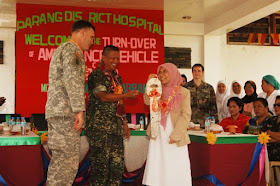 Dentists from the 1st Medical Company provide dental care to one of the 800 patients who came to the medical civil action program in Radapan Aug 18. The AFP medical team joined volunteer caregivers in providing medical checks, dental care, medicines, optometry exams as well as massages and haircuts for the residents of Radapan and surrounding barangays.
Dentists from the 1st Medical Company provide dental care to one of the 800 patients who came to the medical civil action program in Radapan Aug 18. The AFP medical team joined volunteer caregivers in providing medical checks, dental care, medicines, optometry exams as well as massages and haircuts for the residents of Radapan and surrounding barangays.LANAO DEL NORTE, Philippines -- The Armed Forces of the Philippines and Joint Special Operations Task Force – Philippines, along with regional volunteers, brought health care and dialogue to Radapan and surrounding barangays in Lanao del Norte Tuesday with a larger-than-normal Medical Civil Action Program and an open forum called a pulong-pulong.
Despite pouring rains, more than 800 local men, women and children traveled to Radapan, to talk with their community and receive treatment from AFP and JSOTF-P doctors, nurses, and dentists. In addition, volunteer barbers and massage therapists joined in the event to bring additional care to the attendees. “The extra care is the result of our inquiry with the civilians,” said 1st Lt. Rommel De Los Santos, the civil military operations officer for the 33rd Infantry Battalion and organizer of the event. “Previous MEDCAPs we’ve held have been limited to medical and dental, but this is responding to their requests for particular services.” According to a local district supervisor, Hadji Cabina Mamad, the MEDCAP tied in nicely topic with the topic of the pulong-pulong, which was local development. “This medical activity is most important,” said, Mamad. “We believe good health is one of the factors of development.” The event was a visible reminder to local residents that humanitarian operations remain at the forefront of the AFP mission. This region has been on the receiving end of a number of AFP-sponsored SALA’AM activities such as construction projects and educational activities. “This is our continuing mission as far as protecting and helping the people are concerned,” said Brigadier General Rey Ardo, the commander of the 103rd Brigade. As with most MEDCAPS sponsored by the AFP and JSOTF-P, the local community was instrumental in making this event happen. In addition to AFP and JSOTF-P medics, volunteer nurses and students from the local trade skills school assisted with medical treatment. The medicine was provided jointly by JSOTF-P and the local Rotary Club. The amount of local participation was particularly significant because more than half of the participants were from the local community, according to De Los Santos, demonstrating a prime example of the local residents working together to help themselves.


.JPG)
.JPG)

.JPG)
.JPG)
.JPG)

.JPG)
.JPG)
.JPG)
.JPG)
















.JPG)
.JPG)



